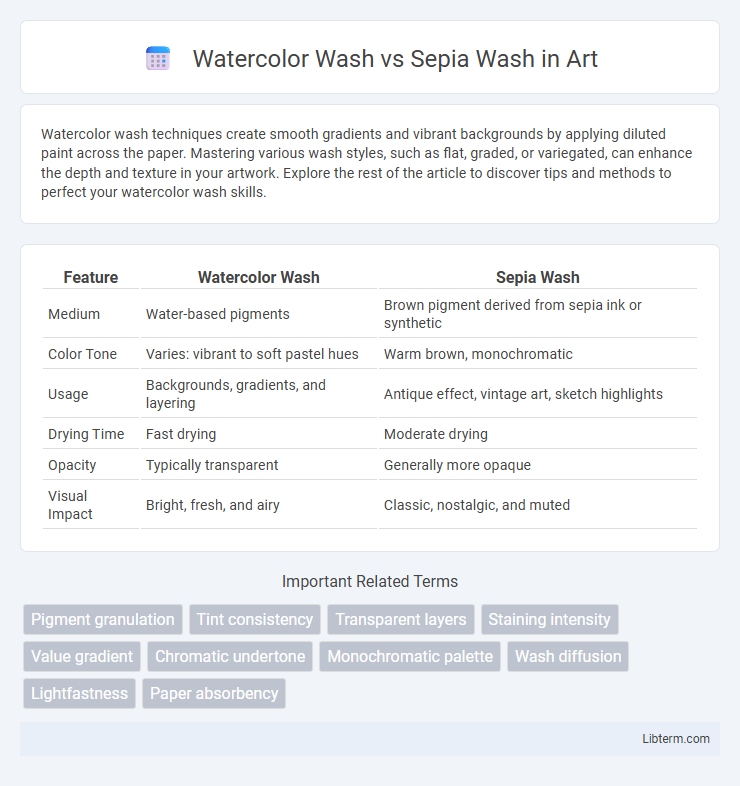Watercolor wash techniques create smooth gradients and vibrant backgrounds by applying diluted paint across the paper. Mastering various wash styles, such as flat, graded, or variegated, can enhance the depth and texture in your artwork. Explore the rest of the article to discover tips and methods to perfect your watercolor wash skills.
Table of Comparison
| Feature | Watercolor Wash | Sepia Wash |
|---|---|---|
| Medium | Water-based pigments | Brown pigment derived from sepia ink or synthetic |
| Color Tone | Varies: vibrant to soft pastel hues | Warm brown, monochromatic |
| Usage | Backgrounds, gradients, and layering | Antique effect, vintage art, sketch highlights |
| Drying Time | Fast drying | Moderate drying |
| Opacity | Typically transparent | Generally more opaque |
| Visual Impact | Bright, fresh, and airy | Classic, nostalgic, and muted |
Understanding Watercolor Wash Techniques
Watercolor wash techniques involve applying a layer of diluted pigment to create a smooth, transparent background or tonal area, with variations such as flat, graded, and variegated washes. Sepia wash specifically uses sepia pigment, derived from natural sources like cuttlefish ink, imparting a warm, earthy tone that enhances vintage or monochromatic artworks. Mastery of both watercolor wash and sepia wash requires control of pigment density, brush stroke, and water ratio to achieve desired gradients and texture effects.
What is Sepia Wash in Art?
Sepia wash in art refers to a watercolor technique using sepia pigment, derived from natural brown tones, to create monochromatic compositions with warm, earthy hues. Unlike a standard watercolor wash that may utilize various colors for blending or layering, sepia wash emphasizes tonal values and contrast to produce vintage or antique effects. This method is popular for sketches, portraits, and landscapes, enhancing depth and mood through subtle gradations of brown.
Historical Context: Watercolor vs Sepia Wash
Watercolor wash has a rich historical context rooted in traditional painting techniques dating back to ancient China and the European Renaissance, where artists utilized diluted pigments to create translucent layers and atmospheric effects. Sepia wash, derived from the ink made from the cuttlefish's ink sac, gained prominence in the 19th century, especially in sepia-toned photographs and vintage art, valued for its warm, monochromatic appeal and durability. Both techniques reflect distinct artistic eras and materials, with watercolor emphasizing color fluidity and sepia highlighting tonal depth and historical nostalgia.
Visual Characteristics: Color and Tone
Watercolor wash features a fluid, translucent quality with vibrant or soft hues that blend seamlessly, creating dynamic gradients and light reflections. Sepia wash presents a warm, monochromatic tone ranging from light tan to deep brown, evoking a vintage or antique aesthetic with subtle variation in intensity. The contrast between the colorful spectrum of watercolor wash and the earthy, muted sepia wash highlights distinct visual atmospheres suited for different artistic moods.
Application Methods Compared
Watercolor wash techniques vary significantly between watercolor wash and sepia wash, primarily in pigment composition and transparency. Watercolor washes use vibrant, diluted pigments applied in broad, fluid strokes to create light-to-dark gradients, enhancing luminosity and blending smoothly with subsequent layers. Sepia washes rely on a monochromatic brown pigment with higher opacity, typically applied with a scrubber brush to build depth and texture, offering a vintage or classic tonal effect ideal for sketches and architectural renderings.
Effects on Mood and Atmosphere
Watercolor wash creates a light, airy atmosphere with its translucent layers and fluid blending, evoking feelings of calmness and openness. Sepia wash imparts a warm, nostalgic mood through its earthy brown tones, often suggesting antiquity or sentimental reflection. The choice between watercolor and sepia washes significantly influences the emotional resonance and depth within a composition.
Best Subjects for Watercolor and Sepia Washes
Watercolor wash excels in capturing vibrant landscapes, floral patterns, and seascapes due to its fluidity and color blending capabilities, making it ideal for subjects requiring a soft, ethereal effect. Sepia wash is best suited for vintage portraits, architectural sketches, and historical scenes, as its warm brown tones evoke nostalgia and timelessness. Both techniques highlight different artistic moods, with watercolor wash emphasizing dynamic color play and sepia wash enhancing texture and depth through monochromatic warmth.
Materials and Tools Needed
Watercolor wash requires high-quality watercolor paints, brushes such as round or flat synthetic or sable brushes, and watercolor paper with good absorbency to achieve smooth gradients and vibrant color blends. Sepia wash specifically uses sepia pigment, traditionally derived from cuttlefish ink or modern sepia-colored watercolors, paired with fine brushes and textured paper to create warm, monochromatic tones for vintage or classical effects. Both techniques benefit from clean water, palettes, and masking tools, but sepia washes often emphasize controlled layering with minimal colors compared to the broader color spectrum needed in typical watercolor washes.
Tips for Beginners: Choosing Your Wash
Watercolor wash offers vibrant, transparent layers ideal for beginners learning color blending and gradients, while sepia wash provides warm, monochromatic tones perfect for creating vintage or classical effects. When choosing your wash, beginners should consider the mood and style of their artwork, with watercolor washes enhancing brightness and variety, and sepia washes adding depth and nostalgic warmth. Experimenting with brush techniques, water dilution, and paper texture can help beginners master each wash and achieve desired results.
Which Wash Technique Suits Your Style?
Watercolor wash offers a vibrant, translucent effect ideal for artists seeking fluidity and color blending, while sepia wash provides a warm, monochromatic tone perfect for vintage or nostalgic styles. Choosing between watercolor and sepia washes depends on whether you prefer bright, dynamic color layering or subtle, earthy hues that evoke timelessness. Assess your artistic goals and desired emotional impact to determine which wash technique aligns best with your style.
Watercolor Wash Infographic

 libterm.com
libterm.com